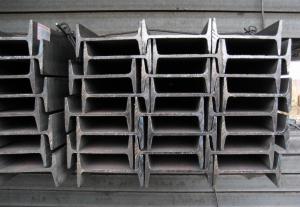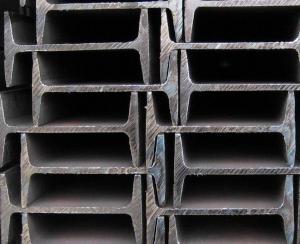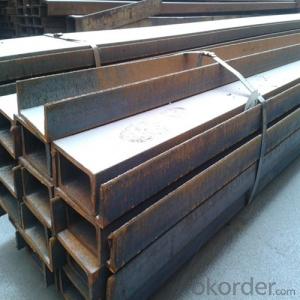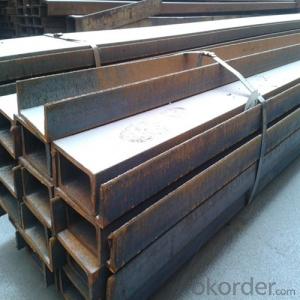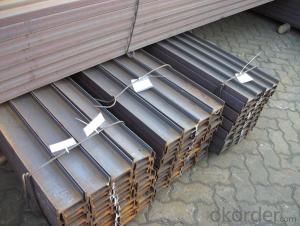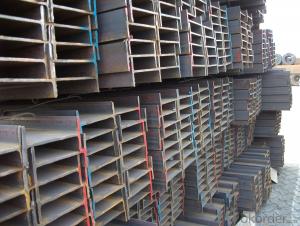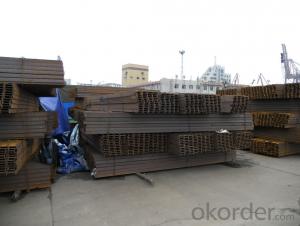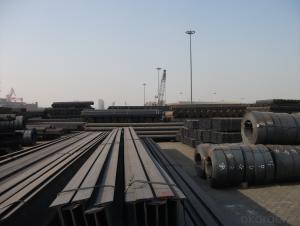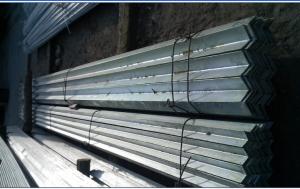High quality IPE with Good Price and Great Quality
- Loading Port:
- Tianjin
- Payment Terms:
- TT OR LC
- Min Order Qty:
- 25 m.t.
- Supply Capability:
- 10000 m.t./month
OKorder Service Pledge
OKorder Financial Service
You Might Also Like
Product Description:
OKorder is offering high quality Hot Rolled Steel I-Beams at great prices with worldwide shipping. Our supplier is a world-class manufacturer of steel, with our products utilized the world over. OKorder annually supplies products to European, North American and Asian markets. We provide quotations within 24 hours of receiving an inquiry and guarantee competitive prices.
Product Applications:
1. Supporting members, most commonly in the house raising industry to strengthen timber bears under houses. Transmission line towers, etc
2. Prefabricated structure
3. Medium scale bridges
4. It is widely used in various building structures and engineering structures such as roof beams, bridges, transmission towers, hoisting machinery and transport machinery, ships, industrial furnaces, reaction tower, container frame and warehouse etc.
Product Advantages:
OKorder's Steel I-Beams are durable, strong, and resist corrosion.
Main Product Features:
· Premium quality
· Prompt delivery & seaworthy packing (30 days after receiving deposit)
· Corrosion resistance
· Can be recycled and reused
· Mill test certification
· Professional Service
· Competitive pricing
Product Specifications:
1. Invoicing on theoretical weight or actual weight as customer request
2. Standard: EN10025, GB Standard, ASTM
3. Grade: Q235B, Q345B, SS400, ASTM A36, S235JR, S275JR
4. Length: 5.8M, 6M, 9M, 12M as following table
5. Sizes: 80mm-270mm
Dimensions(mm) | |||||
h | b | s | t | Mass Kg/m | |
IPE80 | 80 | 46 | 3.80 | 5.20 | 6.00 |
IPE100 | 100 | 55 | 4.10 | 5.70 | 8.10 |
IPE120 | 120 | 64 | 4.80 | 6.30 | 10.40 |
IPE140 | 140 | 73 | 4.70 | 6.90 | 12.90 |
IPE160 | 160 | 82 | 5.00 | 7.40 | 15.80 |
IPE180 | 180 | 91 | 5.30 | 8.00 | 18.80 |
IPE200 | 200 | 100 | 5.60 | 8.50 | 22.40 |
IPE220 | 220 | 110 | 5.90 | 9.20 | 26.20 |
IPE240 | 240 | 120 | 6.20 | 9.80 | 30.70 |
IPE270 | 270 | 135 | 6.60 | 10.20 | 36.10 |
FAQ:
Q1: Why buy Materials & Equipment from OKorder.com?
A1: All products offered byOKorder.com are carefully selected from China's most reliable manufacturing enterprises. Through its ISO certifications, OKorder.com adheres to the highest standards and a commitment to supply chain safety and customer satisfaction.
Q2: How do we guarantee the quality of our products?
A2: We have established an advanced quality management system which conducts strict quality tests at every step, from raw materials to the final product. At the same time, we provide extensive follow-up service assurances as required.
Q3: How soon can we receive the product after purchase?
A3: Within three days of placing an order, we will begin production. The specific shipping date is dependent upon international and government factors, but is typically 7 to 10 workdays.
Images:
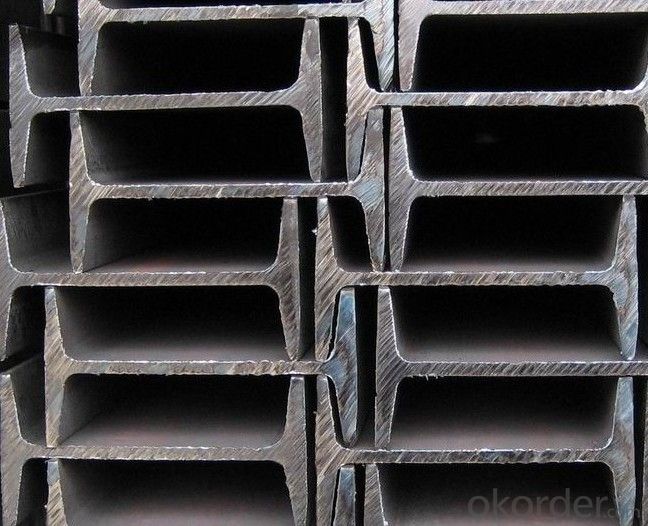
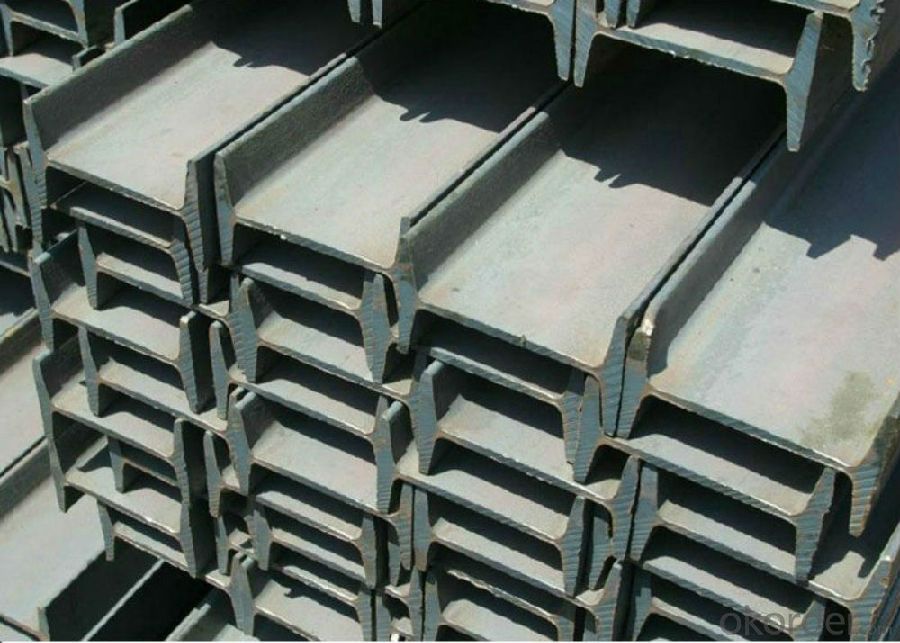
- Q: What are the different types of load tests conducted on Steel I-Beams?
- There are several types of load tests conducted on Steel I-Beams, including ultimate strength tests, yield strength tests, and fatigue tests. Ultimate strength tests determine the maximum load a beam can withstand before failure, while yield strength tests measure the load at which the beam begins to deform permanently. Fatigue tests subject the beam to repeated loading and unloading cycles to assess its resistance to fatigue failure over time.
- Q: Can steel I-beams be used in performing arts venues or theaters?
- Yes, steel I-beams can be used in performing arts venues or theaters. Steel I-beams are commonly used in construction due to their strength and durability. In the context of performing arts venues or theaters, steel I-beams can be utilized in various ways. They can be used as structural elements to support the roof and walls, providing a solid and sturdy framework for the building. Additionally, they can be used to create elevated platforms or catwalks for technicians and performers, ensuring a safe and stable working environment. Moreover, steel I-beams can be used to construct rigging systems for lighting, sound, and special effects equipment, allowing for optimal positioning and movement of these elements during performances. Overall, the use of steel I-beams in performing arts venues offers a reliable and versatile solution for creating a functional and visually appealing space.
- Q: What is the difference between GB and non - marking of I-beam?
- The national standard refers to the approval issued by the national standardization administrative body, which is of great significance to the national economic and Technological Development and is unified throughout the country. The national standards are unified technical requirements throughout the country, and shall be formulated by the administrative department for standardization under the State Council to coordinate the project division of labor, organize the formulation (including revision), and uniformly examine and approve, number and issue.
- Q: Can Steel I-Beams be used for overhead conveyor systems?
- Definitely! Overhead conveyor systems can indeed make use of steel I-beams. Renowned for their robustness and longevity, steel I-beams are an ideal selection for supporting substantial loads across diverse applications. When employed in overhead conveyor systems, they provide a sturdy and secure framework for attaching the conveyor track, guaranteeing seamless and efficient material handling. Moreover, steel I-beams can effortlessly be tailored to meet specific project prerequisites, including length, width, and load capacity. All in all, due to their strength, adaptability, and ability to manage heavy loads, steel I-beams are a dependable and widely favored choice for overhead conveyor systems.
- Q: Can steel I-beams be used for overhead crane support?
- Indeed, overhead crane support can be achieved by employing steel I-beams. These I-beams are extensively utilized in construction and industrial settings owing to their impressive strength and ability to bear heavy loads. They are perfectly suited for accommodating substantial weights while offering the essential stability and structural integrity essential for overhead crane systems. Tailoring the precise size and configuration of the I-beams would naturally be contingent upon the load capacity and span specifications of the overhead crane. Furthermore, it is crucial to guarantee the proper installation and support of the I-beams in order to withstand the dynamic loads and forces exerted by the crane.
- Q: What are the considerations for painting or coating steel I-beams?
- When considering painting or coating steel I-beams, there are several important considerations to keep in mind. 1. Surface Preparation: Before painting or coating steel I-beams, it is crucial to properly prepare the surface. This typically involves cleaning the beams to remove any dirt, grease, or other contaminants. Additionally, any rust or scale should be removed through methods such as sandblasting or wire brushing. Proper surface preparation is essential for ensuring good adhesion and a long-lasting finish. 2. Type of Coating: There are various types of coatings available for steel I-beams, each with its own advantages and considerations. Some common options include epoxy coatings, polyurethane coatings, and zinc-rich primers. The choice of coating will depend on factors such as the environment the beams will be exposed to, the level of corrosion protection required, and aesthetic preferences. 3. Corrosion Protection: Steel I-beams are often exposed to harsh environments that can lead to corrosion, such as moisture, chemicals, or saltwater. Therefore, it is important to select a coating that provides adequate corrosion protection. This can be achieved through the use of primers, sealers, or anti-corrosion coatings. Regular inspections and maintenance should also be conducted to identify any signs of corrosion and address them promptly. 4. Application Method: The method used to apply the paint or coating is another consideration. Common application methods include brushing, spraying, or rolling. The choice of application method will depend on factors such as the size and shape of the I-beams, the desired finish quality, and the available equipment. 5. Safety and Environmental Considerations: When painting or coating steel I-beams, it is important to consider safety and environmental factors. Certain coatings may contain hazardous materials, so proper protective equipment should be used during application. Additionally, it is important to follow local regulations and guidelines regarding the disposal of any waste materials generated during the painting or coating process. Overall, proper surface preparation, selecting the right coating, ensuring corrosion protection, choosing the appropriate application method, and considering safety and environmental factors are all important considerations when painting or coating steel I-beams. These considerations will help ensure a long-lasting finish that provides both aesthetic appeal and protection against corrosion.
- Q: Can steel I-beams be customized for specific projects?
- Yes, steel I-beams can be customized for specific projects. They can be fabricated to meet specific length, size, and load requirements, ensuring optimal structural strength and support for the intended application. Customization options may include altering the dimensions, adding extra reinforcements, or incorporating specific features to suit the project's needs.
- Q: How are steel I-beams fire-rated?
- To enhance their ability to withstand fire and ensure the safety of occupants, steel I-beams can be fire-rated through different methods. One approach is the application of a fire-resistant coating or paint, designed to withstand high temperatures and prevent the steel from reaching critical levels that could lead to structural failure. These coatings act as insulating barriers, slowing down heat transfer and prolonging the beams' integrity during a fire. Two types of coatings commonly used are intumescent, which expand and form an insulating layer when exposed to high temperatures, and cementitious, which provide a fire-resistant barrier. Alternatively, steel I-beams can be encased in fire-resistant materials like concrete or gypsum board. This is typically done during construction to create fire-rated floor and wall assemblies. By enclosing the beams within these materials, a protective barrier is formed, shielding the steel from the fire's heat and enhancing its fire resistance. The fire rating of steel I-beams is determined by factors such as the thickness and type of fire-resistant coating, the insulation properties of the coating, the duration for which the beams can withstand fire, and the type of fire test they have undergone. Testing laboratories, such as UL or ASTM, typically certify fire-rated steel I-beams according to recognized standards. It is important to understand that fire rating does not make steel I-beams completely fireproof. It only provides a certain level of fire resistance for a specific duration. Therefore, it is crucial to adhere to building codes and regulations and regularly inspect and maintain fire-rated steel I-beams to ensure their effectiveness in fire scenarios.
- Q: How do steel I-beams perform in areas with high pollution or chemical exposure?
- Steel I-beams are known for their durability and strength, making them a popular choice for construction projects in various environments. However, in areas with high pollution or chemical exposure, the performance of steel I-beams can be significantly affected. High pollution levels, such as airborne pollutants or corrosive gases, can cause corrosion and degradation of the steel surface. If left untreated, this corrosion can weaken the structural integrity of the I-beams over time. Additionally, chemical exposure, especially to acids or other corrosive substances, can accelerate the corrosion process and further compromise the strength of the steel. To mitigate the impact of high pollution or chemical exposure, several measures can be taken. One common approach is to apply protective coatings to the surface of the I-beams. These coatings act as a barrier, preventing direct contact between the steel and the pollutants or chemicals. Additionally, these coatings can provide resistance against corrosion and extend the lifespan of the I-beams. Another approach is to use stainless steel I-beams, which contain a higher amount of chromium and nickel. This composition makes stainless steel highly resistant to corrosion and chemical exposure. Although stainless steel I-beams are more expensive than regular steel, they are a worthwhile investment in areas with high pollution or chemical exposure. Regular maintenance and cleaning are also essential to ensure the long-term performance of steel I-beams in such environments. Regular inspections can help identify any signs of corrosion or degradation early on, allowing for timely repairs or replacements. In conclusion, while steel I-beams are generally durable, their performance in areas with high pollution or chemical exposure can be compromised. Protective coatings, the use of stainless steel, and regular maintenance are key factors to consider in order to ensure the optimal performance and longevity of steel I-beams in these challenging environments.
- Q: What are the fire protection measures required for steel I-beams in certain applications?
- Fire protection measures required for steel I-beams in certain applications typically include the application of fire-resistant coatings or the use of fire-rated enclosures to prevent structural failure and maintain the integrity of the beams during a fire. Additionally, fireproofing materials such as gypsum-based boards or intumescent paints can be used to insulate the steel beams and delay their exposure to high temperatures. The specific fire protection measures depend on the building codes and regulations, as well as the fire rating requirements for the particular application.
Send your message to us
High quality IPE with Good Price and Great Quality
- Loading Port:
- Tianjin
- Payment Terms:
- TT OR LC
- Min Order Qty:
- 25 m.t.
- Supply Capability:
- 10000 m.t./month
OKorder Service Pledge
OKorder Financial Service
Similar products
Hot products
Hot Searches
Related keywords
